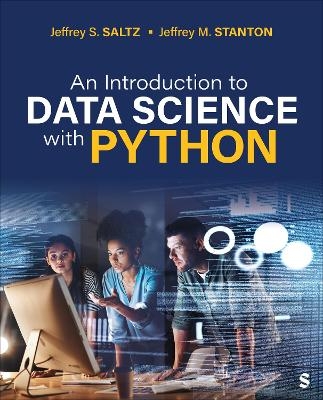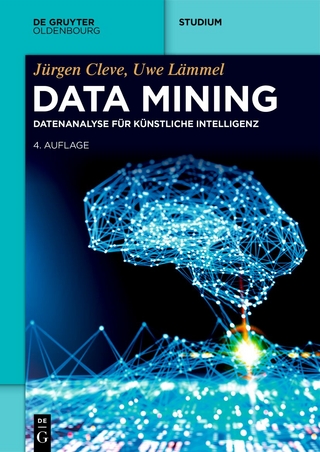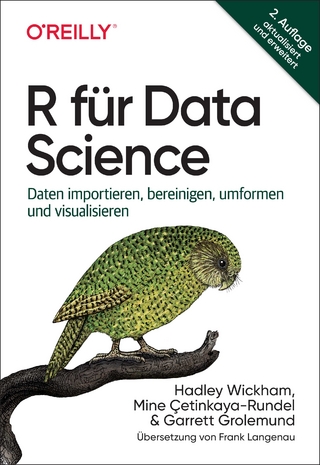
An Introduction to Data Science With Python
SAGE Publications Inc (Verlag)
978-1-0718-5065-7 (ISBN)
An Introduction to Data Science with Python by Jeffrey S. Saltz and Jeffery M. Stanton provides readers who are new to Python and data science with a step-by-step walkthrough of the tools and techniques used to analyze data and generate predictive models. After introducing the basic concepts of data science, the book builds on these foundations to explain data science techniques using Python-based Jupyter Notebooks. The techniques include making tables and data frames, computing statistics, managing data, creating data visualizations, and building machine learning models. Each chapter breaks down the process into simple steps and components so students with no more than a high school algebra background will still find the concepts and code intelligible. Explanations are reinforced with linked practice questions throughout to check reader understanding. The book also covers advanced topics such as neural networks and deep learning, the basis of many recent and startling advances in machine learning and artificial intelligence. With their trademark humor and clear explanations, Saltz and Stanton provide a gentle introduction to this powerful data science tool.
Included with this title:
LMS Cartridge: Import this title’s instructor resources into your school’s learning management system (LMS) and save time. Don′t use an LMS? You can still access all of the same online resources for this title via the password-protected Instructor Resource Site.
Jeffrey S. Saltz is an Associate Professor at Syracuse University in the School of Information Studies and Director of the school′s Master′s of Science program in Applied Data Science. His research and teaching focus on helping organizations leverage information technology and data for competitive advantage. Specifically, his current research focuses on the socio-technical aspects of data science projects, such as how to coordinate and manage data science teams. In order to stay connected to the “real world”, Dr. Saltz consults with clients ranging from professional football teams to Fortune 500 organizations. Prior to becoming a professor, Dr. Saltz′s two decades of industry experience focused on leveraging emerging technologies and data analytics to deliver innovative business solutions. In his last corporate role, at JPMorgan Chase, he reported to the firm′s Chief Information Officer and drove technology innovation across the organization. Jeff also held several other key technology management positions at the company, including CTO and Chief Information Architect. He also served as Chief Technology Officer and Principal Investor at Goldman Sachs, where he helped incubate technology start-ups. He started his career as a programmer, project leader and consulting engineer with Digital Equipment Corp. Dr. Saltz holds a B.S. degree in computer science from Cornell University, an M.B.A. from The Wharton School at the University of Pennsylvania, and a PhD in Information Systems from the New Jersey Institute of Technology. Jeffrey M. Stanton, Ph.D. is a Professor at Syracuse University in the School of Information Studies. Dr. Stanton’s research focuses on the impacts of machine learning on organizations and individuals. He is the author of Reasoning with Data (2017), an introductory statistics textbook. Stanton has also published many scholarly articles in peer-reviewed behavioral science journals, such as the Journal of Applied Psychology, Personnel Psychology, and Human Performance. His articles also appear in Journal of Computational Science Education, Computers and Security, Communications of the ACM, Computers in Human Behavior, the International Journal of Human-Computer Interaction, Information Technology and People, the Journal of Information Systems Education, the Journal of Digital Information, Surveillance and Society, and Behaviour & Information Technology. He also has published numerous book chapters on data science, privacy, research methods, and program evaluation. Dr. Stanton′s research has been supported through 19 grants and supplements including the National Science Foundation’s CAREER award. Before getting his PhD, Stanton was a software developer who worked at startup companies in the publishing and professional audio industries. He holds a bachelor′s degree in Computer Science from Dartmouth College, and a master′s and Ph.D. in Psychology from the University of Connecticut.
Introduction - Data Science, Many Skills
Chapter 1 - Begin at the Beginning With Python
Chapter 2 - Rows and Columns
Chapter 3 - Data Munging
Chapter 4 - What’s My Function?
Chapter 5 - Beer, Farms, Peas, and Statistics
Chapter 6 - Sample in a Jar
Chapter 7 - Storage Wars
Chapter 8 - Pictures vs. Numbers
Chapter 9 - Map Magic
Chapter 10 - Linear Models
Chapter 11 - Classic Classifiers
Chapter 12 - Left Unsupervised
Chapter 13 - Words of Wisdom: Doing Text Analysis
Chapter 14 - In the Shallows of Deep Learning
| Erscheinungsdatum | 13.09.2024 |
|---|---|
| Verlagsort | Thousand Oaks |
| Sprache | englisch |
| Maße | 187 x 231 mm |
| Gewicht | 570 g |
| Themenwelt | Informatik ► Datenbanken ► Data Warehouse / Data Mining |
| Sozialwissenschaften ► Pädagogik | |
| Wirtschaft ► Betriebswirtschaft / Management ► Allgemeines / Lexika | |
| ISBN-10 | 1-0718-5065-2 / 1071850652 |
| ISBN-13 | 978-1-0718-5065-7 / 9781071850657 |
| Zustand | Neuware |
| Informationen gemäß Produktsicherheitsverordnung (GPSR) | |
| Haben Sie eine Frage zum Produkt? |
aus dem Bereich


